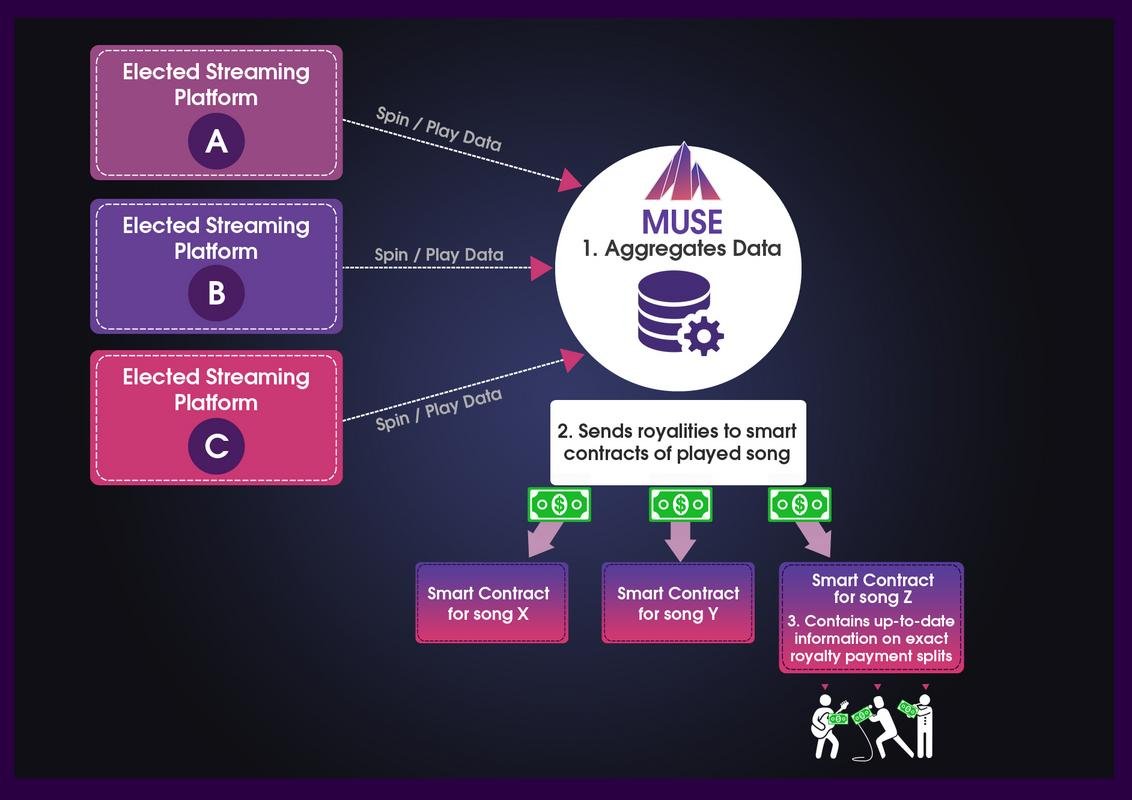This post is aimed at the blockchain/crypto crowd. It will not go into what Muse can do for the music world but merely address the 30 000 foot view of the general architecture from a crypto perspective.
Foundation
Delegated Proof Of Stake
Muse uses DPOS as a consensus mechanism. You can learn all about it here. One of the benefits of DPOS is the way power is distributed as it would in a direct democracy while maintaining the efficiency of a board of directors. Another thing to keep in mind is that DPOS does not require this:

In Bitcoin’s case, someone needs to pay for the upkeep, upgrade and electricity consumption of its mining centers. That someone is the Bitcoin holder. Over 8 million USD per day leaks out of the Bitcoin ecosystem going to the utilities companies and to mining hardware manufacturers. Muse, using DPOS keeps that potential value within the Muse ecosystem. We are thus able to use that wealth to pay those that add value to the ecosystem, in our case, the musician.
Transactions per second
Mass adoption of any product (based on blockchain technology or not) will be hindered by the number of transactions it can handle. The Bitcoin blockchain can only handle 4-7 transactions per second. Ethereum can handle 25 trx/s. Meanwhile, the Muse blockchain can handle at least 50 000 transactions per second. This throughput is vital for anything beyond a mere proof-of-concept.
Smart contract capabilities
Muse is not a Turing complete smart contract platform nor does it claim (or need) to be. Muse was designed to focus on the specific problems plaguing the music world; lack of a central place for reliable music metadata, lack of transparency and high friction (in both fees and wait time) for funds to travel to the proper copyrights holders.
Muse first acts as a global database for music copyright information: trustless, permanent, immutable (history), transparent, open to all and free to access.
This database aspect also applies to content licensing conditions, which can now be displayed publicly. Muse offers one place to view conditions (think block explorer) and even pay for the right to use content then and there. This makes licensing machine-readable for the first time, streamlining it.
The smart contract’s royalty-split section is where musicians using Muse can gain a lot of value. Because of this feature, every time funds are sent to a song’s smart contract, royalties are automatically split between all participants – in a transparent, incorruptible fashion.
It is important to note that the music world is not forced to move all payments onto Muse. Some companies could choose to use Muse merely for figuring out whom to pay and then elect to pay them via another system. If they do choose to use Muse for payments though, they can use its smart contracts.

Note that this section alone is an entire web app in itself and will deserve a post of its own.
Vesting of the core asset
An important feature for a network like Muse is the ability to transfer your MUSE - the core asset of the blockchain - to Vesting. This allows Muse users and MUSE holders a great deal of security and stability, which gives rise to new features that wouldn’t be possible otherwise. Without Vesting, those features would be too dangerous and make the system vulnerable to manipulation.
Example: without vesting, someone wanting to sabotage the network could buy a ton of MUSE, vote in a malicious block producer, then dump his MUSE on the market before anyone realized the network was just attacked. This attack would have incurred no financial cost onto the attacker. On the actual Muse blockchain however, Vesting MUSE is the asset taken into consideration for most blockchain operations, including voting for Witnesses (block producers). With Vesting, the attacker trying to sabotage the network cannot dump his MUSE immediately after the attack since the vesting period locks up that stake for a few weeks. The attacker would go down with the ship.
There are many other situations where Vesting MUSE brings stability and security to the network and its features.
Usability
No transaction fees
Muse users don’t have to pay fees for most day-to-day operations. Updating their smart contract, sending funds around, or receiving their royalties – no transaction fees, no gas – it’s free.
Browser-side front ends
People using this system shouldn’t know they’re using a blockchain at all and Muse was designed with this in mind. Users of all types may interact with the Muse blockchain straight from their web browser. No need to download a client to your desktop or an app to your phone. Simply access one of the Muse front ends from any browser and begin.
Muse Dollars
The Muse Dollar can be redeemed for approximately 1 USD worth of MUSE core asset. It can either be redeemed by the blockchain or traded on the open market. The relative stability provided by the Muse Dollar allows non-traders to embrace the system. The primarily right-brain (hemisphere) dominant artist and creators are diametrically opposed to the left-brain dominant world of financial traders. Musicians need to be paid for their music in something like the dollar, not a volatile crypto-token that acts more like a stock than a currency. They are not interested in “going long”, day trading or “to da moon!” They want to create art and receive compensation in a currency they understand and are familiar with.
Easy onramping – no fiat or crypto required
Users joining the Muse network don’t need to jump through any hoops in order to make use of it. No need to purchase any crypto-tokens, no need to join an exchange and suffer through the KYC and AML regulations and no need to whip out the credit card either. People can simply show up to the website and create an account like they would on any other free service. On top of that, Musicians and curators even receive MUSE and Muse Dollars for participating in the system in various ways but that is beyond the scope of this post.
Extra Features
UIAs
Muse has User Issued Asset functionality, which allows any user to create his or her own crypto-tokens. This will allow different projects that use tokens to change up the entertainment industry, to use Muse as a backbone. This will require a post in itself; just know that this feature is already built into Muse.
Internal market (DEX)
Muse comes with its own decentralized exchange to facilitate the trading of the MUSE core asset, Muse Dollars and all different types of User Issued Assets – no need to go to an external exchange. In other words, the Muse blockchain matches bids and asks and would allow users to trade their “Snoop Tokens” for Muse Dollars.
Scoring
A question that arises often is: How can I trust the content on a blockchain? There is no central authority within Muse that does account verification like Facebook and Twitter currently do for celebrity accounts. Verification on Muse is up to the community and we’ve built the tools that will allow this to happen easily. Each user and smart contract has a score, a sort of “probability that this user/content is legit” score. MuseIDs connect amongst themselves, creating a social graph. Scoring is not calculated merely based on number of links/connections you have but on the Vesting MUSE you and your connections have. That scoring influences the smart contracts in which you are a participant. A streaming platform using Muse could decide to trust only songs that have a scoring above X and ignore anything with a score lower than X. It could also whitelist any content that is connected/linked to a specific MuseID, which they trust. For example: “Any artist connected to the MuseID MusicLawFirm, I will stream on my platform”
Services can also pop up offering MuseID validation. Something similar to the Proof-Of-Physical-Address service on Ethereum where you send them money and a physical mailing address and they send you a postcard with a PIN. If you’ve entered the PIN correctly, this type of entity on Muse could connect up to your MuseID, bringing your score up and possibly whitelisting you and your content on different services.
Curation
People going through content get rewarded for their work as well. Participants that discover and upvote content before it makes it to the top of the Muse charts will receive Vesting MUSE. Another, more powerful, form of curation comes through the UIA functionality described a few paragraphs above. Purchasing an undiscovered artist’s token while it is still very cheap can have tremendous upside from both financial and discovery point of views. The token’s role in curation/talent discovery and fan engagement will be elaborated on in future posts.
Muse IS the royalty paying entity
Not companies, not listeners, but the blockchain itself! All the models currently in existence require humans to pay for the music they stream, whether it’s from listening to advertisements or by paying a subscription fee to the music streaming service. Muse has a budget (based on a % of the market cap) to allocate to the smart contracts of songs that were streamed. Those smart contracts contain the information as to what should be done with the income. Royalties are split instantly, automatically and transparently to the proper copyright holders.

Notice the funds go directly from the Muse entity to the copyright holders. If the Muse Blockchain’s market cap is too low to support the minimum amount of royalties to be paid, then the streaming service must top it off to achieve the desired rate. Streaming platforms essentially get their biggest expense (royalties) subsidized by Muse.
Electing streaming platforms
How does Muse know which smart contract/songs to reward? The music world does not compensate based on votes but based on “spins”. Streaming platforms (like PeerTracks) wishing to get royalties subsidized need to be voted in by MUSE holders. Once voted in, they are able to push their daily spin reports to Muse. The blockchain compiles all spins from all users from all elected platforms and knows exactly how to split up and pay out its royalty pool. Note that funds NEVER pass through the streaming platforms; they go directly to the rights holders from their creation by the blockchain. Streaming platforms merely report what was streamed on their app/service. MUSE holders have the ultimate power when it comes to which services get to push out their reports and receive subsidies and which ones do not. If a platform lacks transparency or misbehaves in any way, MUSE members are free to remove their support by removing their stake-weighted vote. In the end, the MUSE holders have collective control over the entire system.
Conclusion
I hope this helps the crypto crowd understand what we have built. The Muse blockchain has already launched and is tradable on OpenLedger/BitShares under the asset OPEN.MUSEOL here. We are currently building the front ends which will allow the music world to actually make use of Muse. One of my next post will explain what Muse can do for the music world itself - what the effects of Muse will be on that industry.
Stay tuned!
